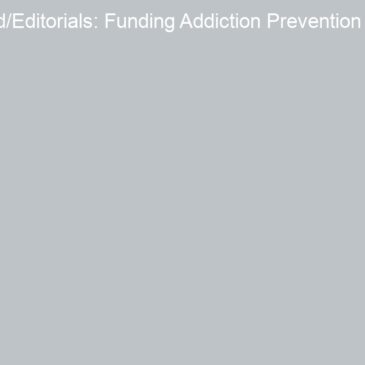The views expressed in the Op-Ed/Editorials page are solely the views of the author(s) and do not necessarily reflect the views of the BASIS, its sponsors, or affiliated organizations.
Allyson Peller is the incoming editor of the online journal, STASH. Allyson received her training in public health. She has written numerous articles for the WAGER, ASHES, the DRAM, Addictions and the Humanities, and STASH during the last year. She is a welcome addition to our editorial team.
— Debi LaPlante Senior Editor, BASIS
Allyson Peller, M.P.H. Incoming Editor, STASH
Prevention programs are the foundation of public health promotion. For chronic behavioral conditions such as addiction, primary prevention programs use health promotion strategies (i.e., education programs) to prevent the development of addictive behaviors. Given the billions of dollars in annual federal spending for addiction treatment and the devastating public health consequences of addictive behaviors (e.g., increased HIV/AIDS and Hepatitis C transmission through intravenous drug use (National Institute on Drug Abuse, 2000), drunk driving fatalities (National Highway Traffic Safety Administration, 2006), lung cancer from exposure to tobacco smoke (Center for Disease Control, 2004)), policymakers should prioritize funding for primary prevention of addictive behaviors. Primary prevention programs are cost-effective: money spent now to develop effective primary prevention strategies will save even more money spent later on addiction treatment, healthcare, and law enforcement to deal with the consequences of addictive behaviors. It is myopic to under-fund primary prevention programs when costs to deal with negative economic and social consequences of addictive behaviors will compound for future generations.
Despite rhetoric to increase addiction prevention programs for youth, the Bush administration’s FY 2007 budget (Office of National Drug Control Policy, 2006) eliminates funding for many federally funded primary prevention programs, such as the Safe and Drug Free Schools program. In addition, the FY 2007 budget reduces research funding for the National Institute on Alcohol Abuse and Alcoholism, and the National Institute on Drug Abuse, precluding some research opportunities to evaluate existing programs or stimulate more effective prevention strategies. Alternatively, the FY 2007 budget allocates increased funding for programs such as Access to Recovery, a program which creates incentives to use faith-based addiction treatment programs, and the Anti-Drug Media Campaign.
The administration uses the Program Assessment Rating Tool (PART) (for further information on PART ratings, see http://www.whitehouse.gov/ omb/part/) to benchmark program performance and guide budgeting decisions. Although this is a standardized, analytic system for rating program success and failures, PART ratings might not be reliable indicators to guide public health decisions. Since policymakers use PART ratings to evaluate a wide range of programs, PART ratings might not be suited to the unique challenges of preventing addictive behaviors (United States General Accounting Office, 2004). For example, unrealistic benchmarks for addiction prevention programs might lead to unnecessary elimination of programs rather than finding ways to improve existing programs. Even if we assume the PART ratings are an accurate indicator, a report by the United States General Accounting Office (2004) noted that policymakers make funding decisions based on their own values and interests rather than the PART ratings. That is, the report found that policymakers gave some programs with ineffective ratings increased funding while giving other programs with ineffective ratings reduced funding.
Given the potential for biased policymaking decisions for addiction prevention programs, all of us need to think critically about the scientific rigor of pertinent research studies that we think should inform policymaking decisions. The mission of the BASIS is to encourage readers to be active consumers of scientific information and delve deeper into the methods, results and implications for improving or changing current practices and policymaking decisions. As editor of STASH, I will collaborate with BASIS staff to present timely and innovative research that focuses on drugs of abuse. In particular, I feel strongly about the importance of primary prevention programs and will present discussions about articles evaluating these programs. For example, this week’s STASH and the previous issue of STASH critically examine potential strengths and weaknesses of addiction prevention programs and raise pertinent issues for future research to investigate for program improvement. Participation in this type of critical thinking inspires the development of innovative research and the creation of more effective public health interventions.
What do you think? Comments on this article can be addressed to Allyson Peller.
References
Center for Disease Control. (2004). Health effects of cigarette smoking: Fact sheet, Tobacco Information and Prevention Source (TIPS). http://www.cdc.gov/tobacco/factsheets/HealthEffectsofCigaretteSmoking_Factsheet.htm.
National Highway Traffic Safety Administration. (2006). 2004 Final traffic safety facts annual report. Retrieved April 19th, 2006, from http://wwwnrd.nhtsa.dot.gov/pdf/nrd-30/NCSA/TSFAnn/TSF2004.pdf
National Institute on Drug Abuse. (2000). The Makings of a Public Health Epidemic: Drug Abuse, HIV/AIDS and Hepatitis C. Retrieved May 19, 2006, from http://www.nida.nih.gov/MedAdv/00/NR5-9.html
Office of National Drug Control Policy. (2006). National Drug Control Strategy FY 2007 Budget Summary Retrieved May 19, 2006, from http://www.whitehousedrugpolicy.gov/publications/policy/07budget/
United States General Accounting Office. (2004). Performance Budgeting: Observations on the Use of OMB’s Program Assessment Rating Tool for the Fiscal Year 2004 Budget. Washington, D.C.





Anonymous July 9, 2009
Drug education can bring positive impact on campaign to prevention on drugs and alcohol addiction. Since victims of addiction problem is getting younger by age, it is necessary to provide children basic information about the negative effects of alcohol and drug dependency.